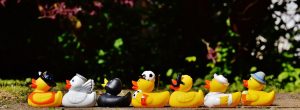A Quacking Song Plot
Sing Ducks Sing: Quacker-Three
Welcome friends to my online blog about my Arts-Based Educational Research (ABER) project, where I am adapting Burke’s play, Ducks on the Moon (2010) into a musical. Some may call this ABER project quackery, but I am already on my third posting, so I am calling this posting quacker-three. In the second posting, I highlighted the different kinds/ways of incorporating music into plays (play-with-music and musical drama) and the different types of musical theatre songs (I Am Song, I Want Song, Comment Song, Metaphor Song, Opening Number, Reprise and Segue, and finally Tent Pole Song). Today, I consider a few guidelines about lyric writing, musical theatre songwriting more generally, and the placement of songs within the musical, or what is sometimes referred to as the Song Plot.

About lyrics…
Writing musical theatre lyrics may be different than writing for smooth jazz or pop songs, but they are some similarities. One truism salient to both genres seems to be: show, don’t tell; or, stated differently “Calling next on the senses will translate abstractions into concreteness. Metaphors, neologisms—whatever hits the fancy, no pondering or editing. Seize.” (Frankel 2000; p. 30). In other words, good lyrics must taste as such; as opposed to be understood as such.
About musical theatre songwriting…
The biggest lesson for me about musical theatre and smooth jazz/pop songwriting is probably THE crucial difference between them: in the theatre songs must have narrative motion; they journey; they ambulate; they arrive. Certainly pop songs may do as well, though it does not appear to be imperative. Indeed, Viertel (2016) recalls “perhaps the greatest example of Hammerstein’s dictum that a song should be a miniature play, with its own movement, conflict and resolution” (p. 64).
About the Song Plot…
From my understanding, a song plot is all the songs in a musical without any dialogue. A songs-only chart allows the writers to examine how the musical narrative flows through music; ideally, one strives for variety and placement: “Musical synopsis shows whether the number is the right one, and in the right place. This includes the alteration of numbers—among the different characters, between solo and group numbers, and among kinds of numbers (ballads, rhythm tunes, special material and production numbers” (Frankel 2000; p. 65). So, the writer should manage dramatic tension through the songs; and one way to do so is to “var[y] rhythmic impulses or charges. High or low, the rhythmic contrast between these charges is what makes them effective” (Frankel 2000; p. 32).
And, of course there are not only rhythmic contrasts, since “the complement of rhythmic contrasts is visual variety. Musical theatre moves figures through mere signals of place, on an open platform of space, and keeps the space free for change; this makes all musicals spectacles” (Frankel 2000; p. 33). And, again the Viertel (2016) suggests that variety is the goal, for “as soon as the audience understood a visual idea and taken pleasure from it, another idea has to be presented. As soon as the sound of a trio has been enjoyed, the quartet has to enter, then the octet, then the entire company” (p. 110).
Conclusions…
So, my next task is to re-read Ducks on the Moon, look for those dramatic high points and create a tentative song plot
References
Burke, K.J. (2010). Ducks on the Moon: A Parent Meets Autism. Hagios Press: Regina, SK.
Frankel, Aaron (2000). Writing the Broadway Musical (Revised and Updated). USA: Da Capo Press.
Viertel, Jack. (2016). The Secret Life of the America Musical: How Broadway Shows are Built. New York: Sarah Crighton Books.